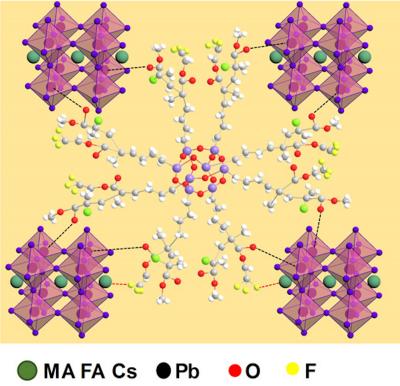Researchers at the Swiss Federal Institute of Technology in Lausanne (EPFL) and Northwestern Polytechnical University in China have fabricated an inverted perovskite solar cell based on a star-shaped polymer that can reportedly improve charge transport and inhibit ion migration at the perovskite interface.
 Schematic diagram of the interaction between the PPP polymer (partial 3D structure) and perovskite. Image from ScienceAdvances
Schematic diagram of the interaction between the PPP polymer (partial 3D structure) and perovskite. Image from ScienceAdvances
The cell has a 'p-i-n' layout and is based on a perovskite material known as CsMAFA modified with a polymer called polyhedral oligomeric silsesquioxane-poly(trifluoroethyl methacrylate)-b-poly(methyl methacrylate) or simply PPP polymer.
The PPP-modified perovskite is described as a densely packed, high-quality film with an average grain size of 350nm, which compares to 260nm of the same perovskite without the new polymer. It also showed improved steady-state photoluminescence (SSPL), which the academics attributed to the PPP molecules that can mitigate the trap density and passivate grain boundaries and surface defects. The PPP polymer was also found to reduce nonradiative recombination, charge-transport losses, and ion migration.
The solar cell achieved a maximum power conversion efficiency of 22.1% and a fill factor of 0.862, which the research group defined as astoundingly high. 'Surface recombination is likely to be the dominant recombination mechanism in the PPP-modified device,' the researchers explained. 'Thus, it appears feasible to further boost the fill factor close to its Shockley Queisser limit of 0.904 by passivating defects in interfaces.'
An encapsulated version of the device also showed good operational stability with almost no change in efficiency after 1,000 hours of maximum power point tracking under one-sun illumination at 45 degrees Celsius.

